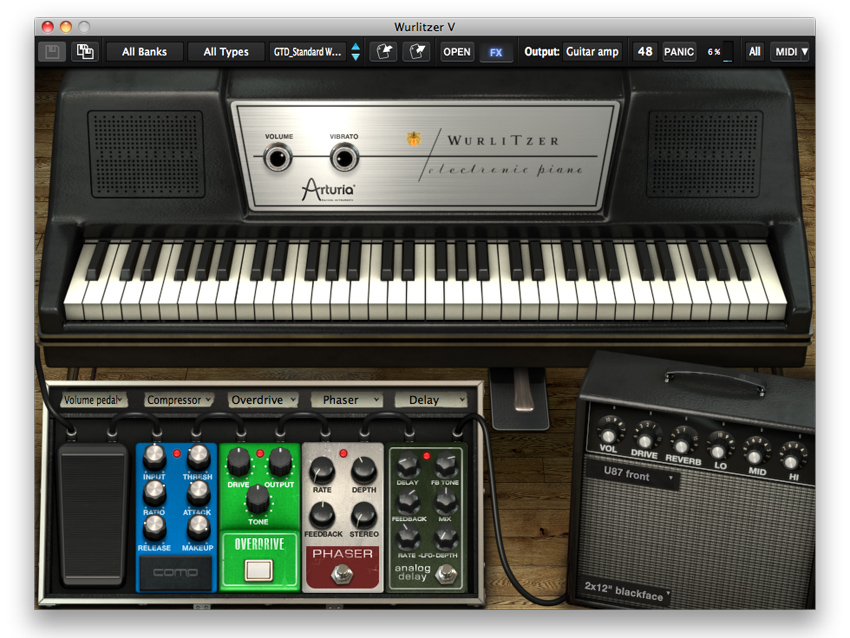Arturia releases Wurlitzer V electric piano

While the Fender Rhodes electric pianos can lay claim to being the most famous in history, many keyboard players cherish the slightly grittier sound of the Wurlitzer EP 200A just as dearly.
This long-standing love affair has now been recognised by Arturia, which has moved away from synth emulations to launch the Wurlitzer V, a physically modelled emulation of the 200A that works standalone and as a plug-in.
Offering you Studio, Stage and Rotary modes, the Wurlitzer V also comes with models of classic tube amps, mics and stompboxes, enabling your to tailor your sound within it.
Find out more on the Arturia website or in the press release below. Wurlitzer V costs €99 as a download and €119 in a box.
Arturia Wurlitzer V press release
Music software and hardware company Arturia is proud to announce availability of Wurlitzer V, a (Standalone, VST 2.4 & 3 -32-bit and 64- bit, RTAS and AU -32- and 64-bit) high-end software recreation of the classic Wurlitzer EP 200A electric piano as of April 26, 2012.
Think electric piano, and many musicians still think Wurlitzer or 'Wurly' -one of a series of electromechanical stringless pianos manufactured and marketed by the US-based Rudolph Wurlitzer Company, coining the trademarked Electronic Piano phrase in the process. The 1972-launched Wurlitzer EP 200A represented Wurlitzer's top-of-the-range, reed-based piano line throughout its impressive 10-year production lifespan; today Arturia's Wurlitzer V faithfully resurrects that still-sought-after sound - and more besides!
Unlike traditional sampling libraries, the Wurlitzer V's embedded physical modelling engine readily reproduces the agreeable acoustic properties of the Wurlitzer EP 200A's musically distinctive reeds, key action, and amplification combo by 'constructing' played notes in real time, creating cost-effective and reliable realism in a computer-based, truly portable package fit for a 21st Century performer; moreover, maximising integral sonic flexibility to skilfully surpass its hardware namesake is also the virtual order of the day here, appealing to studio and stage users alike.
Want all the hottest music and gear news, reviews, deals, features and more, direct to your inbox? Sign up here.
Indeed, Wurlitzer V lets users choose between three output modes: Studio (Wurlitzer V and associated effects are 'connected' to a virtual DI box with reverb thereafter); Stage (with guitar amp simulator, multiple mic and speaker options, and a satisfying-sounding spring reverb at the output stage); and Rotary (with a rotary speaker simulator to create musical movement).
As most producers are already aware, the beloved bright and overdriven 'Wurly' sound so musically ingrained in popular music culture -thanks to artists as diverse as The Beatles, Supertramp, and Marvin Gaye -is actually a clever combination of admirable amplification -Fender Bassman and Twin Reverb guitar tube amps, et al; mic'ing par excellence; and precision processing, with multiple analogue chorus, phasing, and tape echo units often being used to fashion a deeper, luscious tone.
As such, Arturia's Wurlitzer V effectively places its users in an authentic-sounding Seventies-style virtual recording studio, replete with classic tube amps (Fender Deluxe Reverb Blackface, Fender Twin Reverb Blackface, Fender Bassman, and Marshall Plexi guitar tube amp models; Leslie Speaker rotary simulator model); modelled mics (Shure SM57, Sennheiser MD 421, and Neumann U87); and vintage stompboxes (Wah-wah, Autowah, Overdrive, Flanger, Compressor, Phaser, Chorus, Delay, Pitch Shifter/Chorus, Vocal Filter, and Reverb models) -everything needed to achieve that classic 'Wurly' vibe or more adventurous sound design (thanks to advanced in-depth control parameters: 10-band Graphic Equaliser; Vibrator Rate; Pickup Distance; Pickup Axis; Impedance; Damper Position; Dynamics; Octave Stretch; Hammer Hardness; Hammer Noise; Note Off Noise; Sustain Pedal Noise; Velocity Curve).
For anyone looking for an effective electric piano paired with stimulating studio tools (including extensive MIDI mapping of pedals, effects, and sound engine parameters), Wurlitzer V is the answer and you know that for sure!

I’m the Deputy Editor of MusicRadar, having worked on the site since its launch in 2007. I previously spent eight years working on our sister magazine, Computer Music. I’ve been playing the piano, gigging in bands and failing to finish tracks at home for more than 30 years, 24 of which I’ve also spent writing about music and the ever-changing technology used to make it.